Propaganda Between Reels: The Four Minute Men, 1917-1918
May 5, 2011
Back in November STARTS THURSDAY! featured the article Are You Doing Your Bit? which introduced the topic of propaganda slides used in American cinemas during the first world war. Soon after the post went live I was contacted by Krystina Benson, a final year PhD Student in the Creative Industries Faculty at Queensland University of Technology (QUT) in Brisbane who is researching her PhD thesis on this very topic. One conversation led to another, with the ultimate result that Krystina generously agreed to develop an article on the topic specially for STARTS THURSDAY! Please join me in welcoming, and thanking, Krystina for her wonderful contribution.
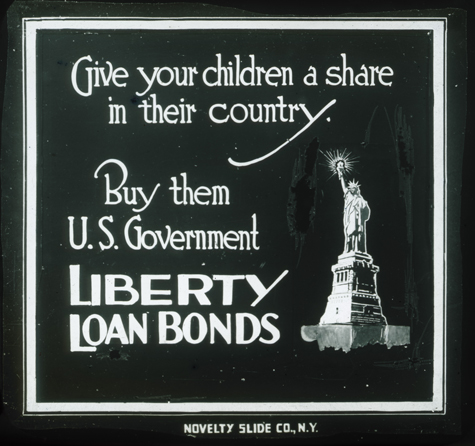
The Committee on Public Information
In 1917, the USA entered the Great War on the side of the allies. Training soldiers and encouraging a community to support the men at the front lines in an overseas battleground in the scale required for The Great War had never occurred before in the United States. In some ways, the distance of the front lines was a benefit and a blessing; in others it was a major challenge. Being able to reach, inform, motivate and organise millions of Americans to go to war required a massive communicative and persuasive effort. President Wilson and his administration recognised that the nation’s support was required for the war effort to succeed, but public opinion was varying about entering the war. Only days after the United States officially declared war, the Committee on Public Information was created to propagandise the U.S. with the goal of uniting and mobilising the fractioned population. George Creel, Director of the CPI explained that its purpose,
. . . in all things, from the first to the last, without halt or change, it was a plain publicity proposition, a vast enterprise in salesmanship, the world's greatest adventure in advertising. There was no part of the great war machinery that we did not touch, no medium of appeal that we did not employ (Creel, 2006, 4)
The CPI delivered the first campaign of its kind, a transmedia campaign that propagated through a multi-media platform incorporating text, image, moving images, speech, and live events, on a broad scale, over geographic and cultural obstacles with efficiency and efficacy (Benson, 2010, 151). The CPI was divided into two main areas: the Domestic Section and the Foreign Section, and was further broken down into divisions. The Foreign Section was created to propagandise abroad. The Domestic Section was created to mobilize Americans into war. This section included the Division of the Four Minute Men, the Speaking Division, the Bureau of State Fair Exhibits, and the Bureau of War Expositions, the Division of Films, the News Division, Advertising Division, the Division of Pictorial Publicity, the Bureau of Cartoons, the Division of Syndicated Features, the Division of Civic and Educational Cooperation, the Division of Work with the Foreign Born, the Division of Women’s War Work, among many others. The CPI persuaded America to support the country’s entrance into World War I and propagandised the government’s aims of:
- Conserving food
- Organising war industry businesses and supplies
- Recruiting war labour
- Propagating war, especially through appeals to emotion
- Informing the population of war news
- Developing laws for and enacting conscription
- Funding the war through income taxes
- Educating and selling forms of investment for the public to invest in the war
- Generating hatred of the enemy and cooperation with the allies
- Creating a patriotic nation and support for democracy promotion
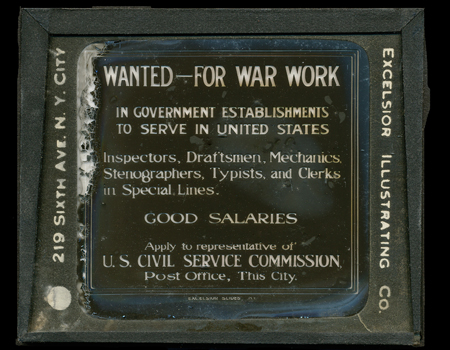
Enter Popular Culture
The motion-picture industry was in its infancy when World War I broke out, but attending films at the cinema was becoming a popular activity leading up to the war (Bakker, 2007, 93). At the time, President Wilson was thought not to have “much respect for the film industry” and Congressmen had pressured “Hollywood producers to withdraw their pacifist, anti-war films” (Manchel, 1990, 223) before the start of the war. However, when Creel was approached with the idea of the Four Minute Men – orators who would speak for four minutes during the reel change at a movie theatre – the government’s approach to the industry quickly changed. The Four Minute Men became the official speakers of the government and spoke mainly at motion picture theatres. Nelson (1918) explains the purpose of Four Minute Men was to reach the public,
[n]ot through the press, for they do not read; not through patriotic rallies, for they do not come. Every night eight to ten million people of all classes, all degrees of intelligence, black and white, young and old, rich and poor, meet in the moving picture houses of this country, and among them are many of these silent ones who do not read or attend meetings but who must be reached (252).
The motion pictures themselves were also useful to show information in narrative form and the CPI set up the Division of Films to create propaganda movies such as Pershing’s Crusaders (1918). Theatre patrons were a ready-made audience and advertising for motion pictures also provided another entry point for publicity. The Four Minute Men’s speech topic for the evening was often published alongside movie listings in the newspapers as the local FMM Chairman would write the newspaper regularly to promote the appearances. Below is a page from a Four Minute Men Bulletin, which the speakers received for each new campaign. It shows clippings of the vast amount of publicity newspapers published about the speeches.
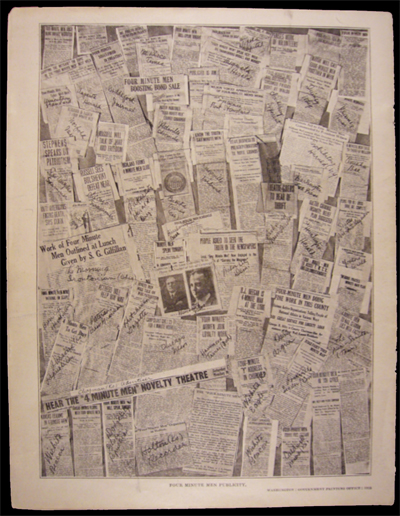
The FMM had national backing from the motion picture theatre industry and this was publicised in newspapers through a letter written by President Wilson. There was an agreement between them that no other organisations would be allowed to use motion picture theatres for speeches.
Rather than full length feature films, in 1917 most evenings were composed of a variety of lengths and types. A typical evening would begin with a film, and then “when the hero and heroine had walked hand in hand into the sunset, ending the “first show” of the evening, the pianist might shift from “Hearts and Flowers” to “Over There,” a slide would be thrown into the screen and one of Mr. Creel’s Four-Minute Men would take the stage” (Mock and Larson, 1939, 114). During the intermission occurring after 8:00pm, the speeches would be presented during the four minutes it took to change reels (117). Stereopticon slides were used to project images on the screen. These glass slides contained room for an orator to write their name, and in the text that follows it stated that they were speaking about something of national importance. Sometimes, later on in the war and when budgets allowed it, slides were used to illustrate campaigns.
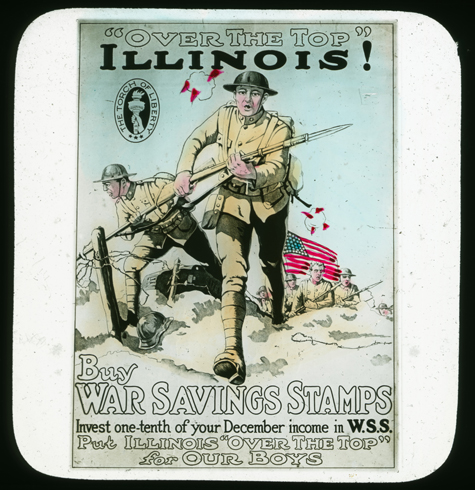
Fred A. Wirth, a Four Minute Man from Chicago wrote a poetic speech entitled The Part of the Four Minute Man (USCPI, 1919, 25). He describes the FMM as “a Stoker for the Great Melting Pot. In four minutes, I breathe the flame of true American Patriotism to people of all kinds and creeds” (24). He also describes himself as a “Soldier” fighting against “German propaganda, intrigue, falsehoods, treachery,” a “Salesman” of “Liberty Bonds and Thrift Stamps,” and a “Preacher who invokes “Loyalty, Patriotism, Devotion” among many other roles (24-25). He begins and in reverse order ends the poem with the same lines,
I am the Mouthpiece of Democracy.
I make men THINK.
I am a Four-Minute Man (25).
The FMM were the central speaking organisation of the government and they gave campaigns based on requirements from government departments whom cooperated to produce some of the most well known public campaigns in American history.
Speaking topics generally ran for two to three week periods. Topics covered a variety of themes such as campaigns with the Treasury department covering four Liberty Loan drives, a drive for War Stamps and Thrift Stamps and Income Tax education. The CPI persuaded audiences to join the food drive with the Food Administration, ran educational and fundraising campaigns for the American Red Cross, recruited for the Army, Navy and war industries and propagated nationalism, patriotism, hatred for the enemy and democracy.
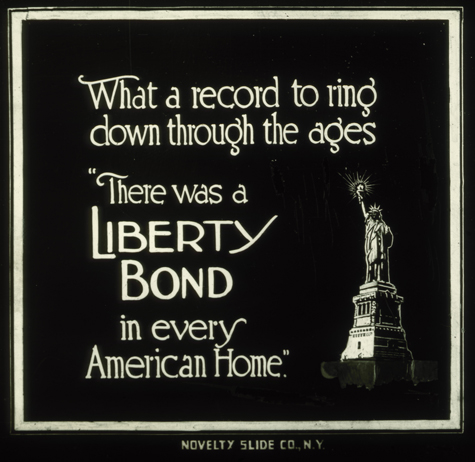
The national Four Minute Men began their craft encouraging citizens to purchase Liberty Loans. Earliest signs of the capabilities of this network of speakers were shown in the 52 per cent over subscription of the first Liberty Loan which raised over four billion dollars (Mock and Larson, 1939, 116). Creel promoted that “when the armistice brought activities to a conclusion, the Four Minute Men numbered 75,000 speakers, more than 7,555,190 speeches had been made, and a fair estimate of audiences makes it certain that a total of 134,454,514 people had been addressed” (85). Combining incomplete reports and speeches that were not included within the date set of the official files, Creel estimates that 4 million people were reached in 18 months with “an average of 28,000 speeches, reaching more than 11,000,000 people, during each of the 36 district campaigns covered by the 46 bulletins” (94).
Financing the war was one of the most important factors in winning the war. Seven different campaigns were created for the U.S. Treasury. The Americans needed to raise funds for ships, ammunition, tanks, uniforms, training camps and crucial infrastructures. In addition, they were supplying the British and other allies with equipment and food. This lead to the necessity of war bonds which took the form of ‘Liberty Bonds’, war savings and thrift stamps and an increase in federal income taxes.
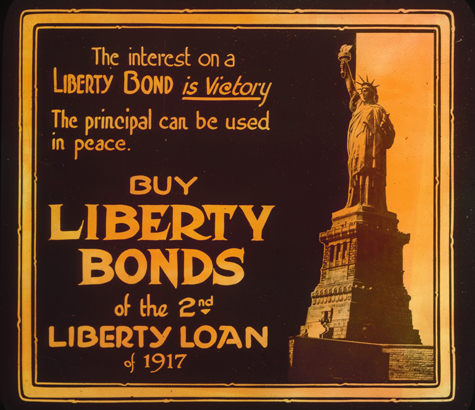
The first liberty loan drive was the basis of the Four Minute Men’s first bulletin outlined campaign. Four Liberty Loan campaigns were carried out in all. All of the drives were very successful and were oversubscribed.
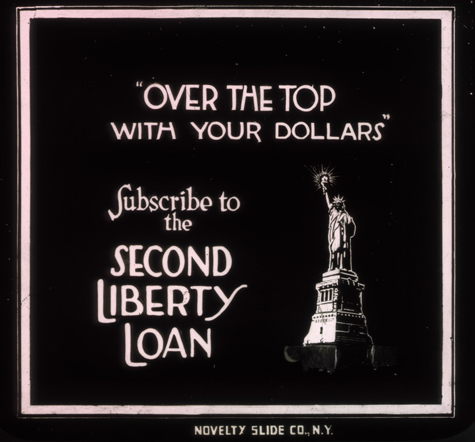
Another method of raising funds for the war were through the sale of thrift stamps and war saving stamps. The Four Minute Men were sending “a vital message” to “Save, save, save, and help the country win the war” (Bulletin 32, 1918, 1). Stamps were described as “A Good Investment” and “Thrift a Patriotic Duty” (4) and were told that, “Savings are the sinews of war” (4). Thrift stamps were targeted towards children because they were much more affordable at cost of twenty-five cents than the liberty loans. Once sixteen thrift stamps were collected, they could be traded in for interest bearing war stamps (3).
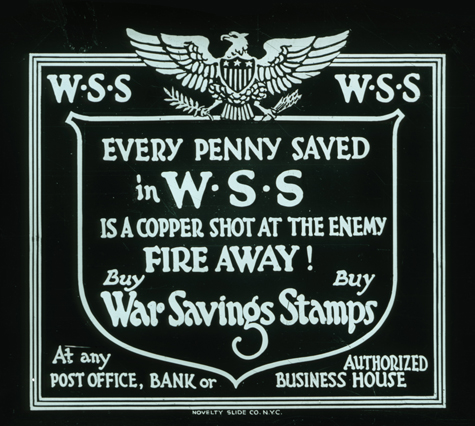
The Food Administration promoted growing your own food at home, community canning and jarring gatherings, meatless days of the week, and conserving food.
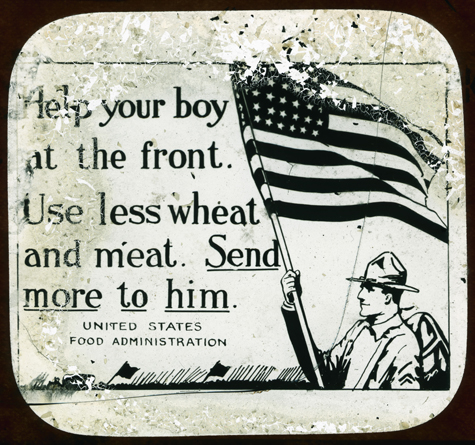
The First Lady, Mrs. Wilson, was the first woman to sign the Food Pledge.
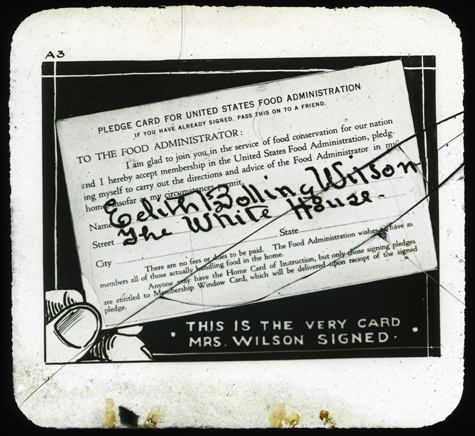
Three Red Cross campaigns were orated by the Four Minute Men. This included Red Cross Weeks and the Red Cross Christmas Roll Call. The first Red Cross Week Campaign was created to raise a billion dollars for Red Cross work. The purpose of the speaking campaign was to inform and help the community accept (if needed) the quota which had been estimated for their town or city, to encourage them to show their patriotism by “exceeding its quota” and to explain how to donate money (Bulletin 5, 1917, 1). The speakers were asked educate the audience to help them “appreciate the occasion,” “understand the need,” “accept the local quota,” “to feel the personal obligation,” “to get the spirit of patriotic sacrifice,” “to correct certain misapprehensions,” “to understand how to subscribe,” and finally, “to feel the sentiment that moves to action” (Bulletin 5, 1917, 1-2).
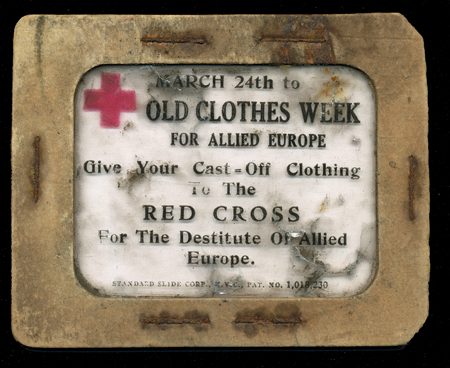
The second Red Cross Campaign also raised money for its war fund. This bulletin has an image is a woman in a red cross hat, wrapped in a gown holding a hurt bandaged soldier, posing in the form commonly associated with Mary or a female saint. This campaign is particularly emotionally targeted as it centres on avoiding suffering for American soldiers. One section describes the “terrible tales” of “the shortage of bandages and shortage of anaesthetics (sic) in European conflicts” and continues “let us home that an American soldier’s wounds need never be dresses with straw and bandaged with newspaper” (Bulletin 30, 1918, 3).
Vaughn (1979) explains that the FMM “proved extraordinarily successful for perhaps three reasons—the use of voluntary local speakers, the ability to use ready-made audiences, and a tight control from national headquarters in Washington” (120). It was not until after WWI that Americans began to perceive the meaning of the word ‘propaganda’ with negative connotations due to public concerns about being controlled and manipulated during the war. The war “made propaganda a key term of social thought” and “Americans gradually learned that their picture of the war was not solely a product of objective information and rational analysis, but was also seasoned with the practices and prejudices” (Sproule, 1987, 62). The Committee on Public Information changed the landscape of media campaigns and the public’s relationship with propaganda, journalism and popular culture. One particularly result was the public’s mistrust in journalism, an increase in public relations materials in newspapers and a lack of understanding about the necessity of the system to rely on all three (Benson, Forthcoming). The CPI was the crux for modern public relations and advertising practices. The practice of recruiting soldiers for the American Army in cinemas began during WWI and continues as a recruitment method via movie previews for the American Department of Defense nearly a century later.
-- KRYSTINA BENSON
Krystina Benson is a final year PhD Student in the Creative Industries Faculty at Queensland University of Technology (QUT) in Brisbane, Queensland, Australia. She will soon complete her thesis entitled The Relationship Between Propaganda, Journalism and Popular Culture which discusses the CPI as a case to inform the study. Currently, she is an Adjunct Lecturer in Public Relations at Bond University and a Sessional Academic in Media and Communication at QUT. She can be reached at Krystina [dot] Benson [at] gmail [dot] com
Bibliography
Archives and Collections
Library of Congress, Washington D.C., USA.
Bulletin / 4 Minute Men 4. [Washington, D.C. : Division of Four Minute Men, Committee on Public Information], 1917-1918. LC Control No.:sn 85064817 All bulletins are from this collection.
Mark Johnson Collection
Second Liberty Bond Loan Drive Slide Image Over the Top Illinois Slide ImageNational Archives and Records Administration, Archives II, College Park, Maryland
Record Group 63 Committee on Public Information RG63, CPI 1-D1. The Activities of the Committee on Public Information, Press edition Niles Essanay Silent Film Museum, Niles, California, USA. All slide images unless otherwise noted.
References
Benson, Krystina L. (2010). Archival Analysis of the Committee on Public Information: The Relationship between Propaganda, Journalism and Popular Culture. The International Journal of Technology, Knowledge and Society. Vol. 6, No. 4, 151-164.
Bakker, Gerbin. (2007). The Evolution of Entertainment Consumption and the emergence of cinema, 1890-1940. The Evolution of Consumption: Theories and Practices. Eds. Marina Bianchi. 93-138 Oxford: Emerald Group Publishing.
CPI (Committee on Public Information). (1920). “Complete Report of the Chairman of the Committee on Public Information 1917: 1918: 1919”. Washington Government Printing office. Retrieved online at: http://www.archive.org/details/completereportof00unit Accessed June 20, 2010.
Creel, George. (2006). How We Advertised America. The First Telling of the Amazing Story of the Committee on Public Information that Carried the Gospel of Americanism to Every Corner of the Globe. (First Published: USA, Harper and Brothers, 1920). New Hampshire: Ayer Company Publishers, Inc.
Manchel, Frank. (1990). Film Study: an analytical bibliography. U.S.A.: Associated University Presses Inc.
Mock, James R. (1941). Censorship 1919. New York: Princeton University Press.
Nelson, Bertram. (1918). “The Four Minute Men.” Eds. Montaville Flowers. What every American should know about the war; a series of studies by the greatest authorities of Europe and America covering every aspect of the great struggle, delivered at the National conference of American lecturers, Washington, D. C., April 8-13. New York: George H. Doran Company. Retrieved online at: http://books.google.com.au/books?id=KOl8ZwVFZ5gC&printsec=frontcover&dq=What+Every+American+Should+Know+about+the+War++By+Montaville+Flowers&hl=en&ei=vATuTMeVDIj0vQOhvLTdDQ&sa=X&oi=book_result&ct=result&resnum=1&ved=0CCUQ6AEwAA#v=onepage&q&f=false Accessed January, 9, 2011.
Sproule, J. Michael. (1987). “Propaganda Studies in American Social Science: The Rise and Fall of the Critical Paradigm." Quarterly Journal of Speech 73, 60–78.
USCPI. United States, Committee on Public Information. Division of Four Minute Men. Chicago Branch. (1919). The Four Minute Men of Chicago. Chicago: History Committee of the Four Minute Men of Chicago. Retrieved online at: http://www.archive.org/details/fourminutemenofc00unit Accessed March, 20, 2010.
Vaughn, Stephen. (1980). Holding Fast the Inner Lines: Democracy, Nationalism, and the Committee on Public Information. Chapel Hill: The University of North Carolina Press.
